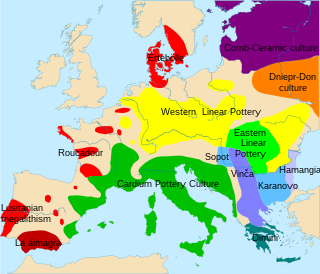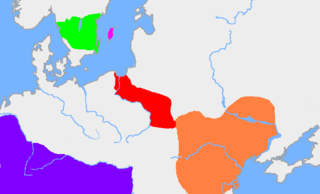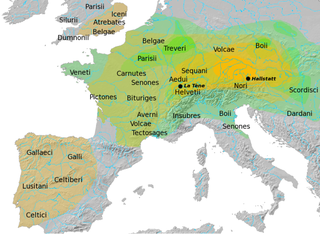 W
WThe Basarabi culture was an archaeological culture in Southeastern Europe, dated between 8th - 7th centuries BC. It was named after Basarabi, a village in Dolj County, south-western Romania, nowadays an administrative component of the Calafat municipality. It is sometimes grouped with related Bosut culture, into the Bosut-Basarabi complex.
 W
WThe Bijelo Brdo culture or Bjelo-Brdo culture is an early medieval archaeological culture flourishing in the 10th and 11th centuries in Central Europe. It represents a synthesis of the culture introduced in the Carpathian Basin by the conquering Hungarians around 900 and of earlier cultures existing in the territory before the Hungarian conquest. Female dress accessories, including "jewellery of plaited wire, two-piece sheetwork pendants, snake-head bracelets and S-shaped temple-reings", are the most characteristic items of the culture. The culture disappeared around 1100, most probably not independently of laws adopted under Kings Ladislaus I and Coloman of Hungary which prescribed the burial of dead in graveyards developed near churches.
 W
WThe Boian culture, also known as the Giulești–Marița culture or Marița culture, is a Neolithic archaeological culture of Southeast Europe. It is primarily found along the lower course of the Danube in what is now Romania and Bulgaria, and thus may be considered a Danubian culture.
 W
WThe Bug–Dniester culture was the archaeological culture that developed in the chernozem region of Moldavia and Ukraine around the Dniester and Southern Bug rivers in the Neolithic.
 W
WBükk culture may have belonged to a dense pocket of Cro-magnon type people inhabiting the Bükk mountains of Hungary and the upper Tisza and its tributaries. The surrounding Neolithic was mainly of a more gracile Mediterranean type, with a Cro-magnon admixture as another possibility. As to whether the Cro-magnons were a remnant squeezed into this pocket, there is no sign of conflict there and the Cro-magnons were doing rather well in the obsidian trade. They were, so to speak, the wealthy men of the European Neolithic.
 W
WThe Carpathian Tumuli culture is the name given to an archaeological culture which evolved in the parts of the Carpathian Mountains between the end of the 2nd and end of the 4th century AD. It was less vast than the area occupied by the Lipiţa culture, encompassing today's Pokuttya, Maramureş, Bucovina and to a lesser extent, Northwest Moldova.
 W
WThe Chernyakhov culture, Černjachov, or Sântana de Mureș culture, is an archaeological culture that flourished between the 2nd and 5th centuries AD in a wide area of Eastern Europe, specifically in what is now Ukraine, Romania, Moldova and parts of Belarus. The culture is thought to be the result of a multiethnic cultural mix of the Sarmatian, Slavic, Gothic, and Geto-Dacian populations of the area.
 W
WThe Coţofeni culture, generally associated with the Usatovo culture, was an Early Bronze Age archaeological culture that existed between 3500 and 2500 BC in the mid-Danube area of south-eastern Central Europe.
 W
WThe Cucuteni–Trypillia culture, also known as the Tripolye culture, is a Neolithic–Eneolithic archaeological culture of Eastern Europe.
 W
WThe term Danubian culture was coined by the Australian archaeologist Vere Gordon Childe to describe the first agrarian society in central and eastern Europe. It covers the Linear Pottery culture, stroked pottery and Rössen cultures.
 W
WThe Epigravettian was one of the last archaeological industries and cultures of the European Upper Paleolithic. It emerged after the Last Glacial Maximum around ~21,000 cal. BP and is considered to be a cultural derivative of the Gravettian culture. Initially named Tardigravettian in 1964 by Georges Laplace in reference to several lithic industries, found in Italy it was later renamed in order to better emphasize its independent character.
 W
WThe Globular Amphora culture, c. 3400–2800 BC, is an archaeological culture in Central Europe. Marija Gimbutas assumed an Indo-European origin, though this is contradicted by newer genetic studies that show a connection to the earlier wave of Neolithic farmers rather than to invaders from the Ukrainian and western-southern Russian steppes.
 W
WThe Gumelniţa–Karanovo VI culture was a Neolithic culture of the 5th millennium BC, named after the Gumelniţa site on the left (Romanian) bank of the Danube.
 W
WThe Hallstatt culture was the predominant Western and Central European culture of Late Bronze Age from the 12th to 8th centuries BC and Early Iron Age Europe from the 8th to 6th centuries BC, developing out of the Urnfield culture of the 12th century BC and followed in much of its area by the La Tène culture. It is commonly associated with Proto-Celtic populations. Older assumptions of the early 20th century of Illyrians having been the bearers of especially the Eastern Hallstatt culture are indefensible and archeologically unsubstantiated.
 W
WThe Hamangia culture is a Late Neolithic archaeological culture of Dobruja between the Danube and the Black Sea and Muntenia in the south. It is named after the site of Baia-Hamangia, discovered in 1952 along Golovița Lake.
 W
WThe Ipotești–Cândești culture was an archaeological culture in Eastern Europe. It developed in the mid-6th century by the merger of elements of the Prague-Penkovka and Prague-Korchak cultures and local cultures in the area between Prut and Lower Danube. It stretched in the Lower Danube over territory in Romania and Moldova. The population of the area was made up of Romanized descendants of Daco-Getic (Daco-Romans), Germanic and Slavic tribes. There are views that it derived from the Chernyakhov culture and represented a group of the Antes. The houses were identical to the Slavic huts of the Prague-Korchak and Penkovka areas. The sites in Romania are known as Ipotești-Candești-Ciurel or Ipotești-Ciurel-Cândești.
 W
WThe Iron Gates Mesolithic is a Mesolithic archaeological culture, dating to between 11,000 and 6,000 years BCE, in the Iron Gates region of the Danube River, in modern Romania and Serbia.
 W
WThe Körös culture/Criș culture is a Neolithic archaeological culture in Central Europe that was named after the river Körös in eastern Hungary. The same river has the name Criș in Romania, hence the name Criş culture. The 2 variants of the river name are used for the same archaeological culture in the 2 regions. The Criș culture survived from about 5800 to 5300 BC. It is related to the neighboring Starčevo culture and is included within a larger grouping known as the Starčevo–Körös–Criş culture.
 W
WThe La Tène culture was a European Iron Age culture. It developed and flourished during the late Iron Age, succeeding the early Iron Age Hallstatt culture without any definite cultural break, under considerable Mediterranean influence from the Greeks in pre-Roman Gaul, the Etruscans, and Golasecca culture, but whose artistic style nevertheless did not depend on those Mediterranean influences.
 W
WThe Linear Pottery culture is a major archaeological horizon of the European Neolithic, flourishing c. 5500–4500 BC. It is abbreviated as LBK, and is also known as the Linear Band Ware, Linear Ware, Linear Ceramics or Incised Ware culture, and falls within the Danubian I culture of V. Gordon Childe.
 W
WLipitsa culture is the archaeological material culture supposedly representative of a Dacian tribe. It took its name from the Ukrainian village of Verkhnya Lypytsya, Ivano-Frankivsk Raion, Ivano-Frankivsk Oblast.
 W
WThe Prehistory of Transylvania describes what can be learned about the region known as Transylvania through archaeology, anthropology, comparative linguistics and other allied sciences.
 W
WThe Penkovka culture is an archaeological culture in Ukraine spanning Moldova and reaching into Romania. Its western boundary is usually taken to at the middle Prut and Dniester rivers, where contact with the Korchak culture occurs. Its bearers are commonly identified as the Antes people of 6th-century Byzantine historiography.
 W
WThe Prehistory of Transylvania describes what can be learned about the region known as Transylvania through archaeology, anthropology, comparative linguistics and other allied sciences.
 W
WThe Prehistory of Transylvania describes what can be learned about the region known as Transylvania through archaeology, anthropology, comparative linguistics and other allied sciences.
 W
WThe Starčevo culture is an archaeological culture of Southeastern Europe, dating to the Neolithic period between c. 6200 and 4500 BCE. It originates in the spread of the Neolithic package of peoples and technological innovations including farming and ceramics from Anatolia to the area of Sesklo. The Starčevo culture marks its spread to the inland Balkan peninsula as the Cardial ware culture did along the Adriatic coastline. It forms part of the wider Starčevo–Körös–Criş culture which gave rise to the central European Linear Pottery culture c. 700 years after the initial spread of Neolithic farmers towards the northern Balkans.
 W
WThe Tiszapolgár culture or Tiszapolgár-Româneşti culture was an Eneolithic archaeological culture of the Great Hungarian Plain, the Banat, Eastern Slovakia and Ukrainian Zakarpattia Oblast in Central Europe.
 W
WThe Urnfield culture was a late Bronze Age culture of Central Europe, often divided into several local cultures within a broader Urnfield tradition. The name comes from the custom of cremating the dead and placing their ashes in urns which were then buried in fields. Over much of Europe, the Urnfield culture followed the Tumulus culture and was succeeded by the Hallstatt culture. Some linguists and archaeologists have associated this culture with the Proto-Celtic language, or a pre-Celtic language family.
 W
WThe Usatovo culture is a late variant of the Cucuteni–Trypillia culture which flourished northwest of the Black Sea from 3500 BC to 3000 BC.
 W
WThe Vatin culture is a name of an prehistoric Bronze Age culture, which was named after village Vatin in Serbia. The culture had Indo-European roots and was culturally connected with Mycenaean Greece. The Vatin culture is dated to the middle Bronze Age and it is generally divided into three phases: Pančevo-Omoljica, Vatin-Vršac, and Belegiš-Ilandža. It flourished from 16th to 13th century BC.
 W
WThe Vinča culture, also known as Turdaș culture or Turdaș–Vinča culture, was a Neolithic archaeological culture in southeastern Europe, in present-day Serbia, and smaller parts of Bulgaria, Kosovo, North Macedonia, Greece and Romania, dated to the period 5700–4500 BC or 5300–4700/4500 BC. Named for its type site, Vinča-Belo Brdo, a large tell settlement discovered by Serbian archaeologist Miloje Vasić in 1908, it represents the material remains of a prehistoric society mainly distinguished by its settlement pattern and ritual behaviour.
 W
WThe Vučedol culture flourished between 3000 and 2200 BCE, centered in Syrmia and eastern Slavonia on the right bank of the Danube river, but possibly spreading throughout the Pannonian plain and western Balkans and southward. It was thus contemporary with the Sumer period in Mesopotamia, the Early Dynastic period in Egypt and the earliest settlements of Troy. Some authors regard it as Bell Beaker during the Kurganization of Europe.
 W
WThe Wietenberg culture was a Middle Bronze Age archeological culture in Central Transylvania that roughly dates to 2200–1600/1500 BCE. Represented a local variant of Usatovo culture and was replaced by Noua culture. Its name was coined after the eponymic Wietenberg Hill near Sighișoara.